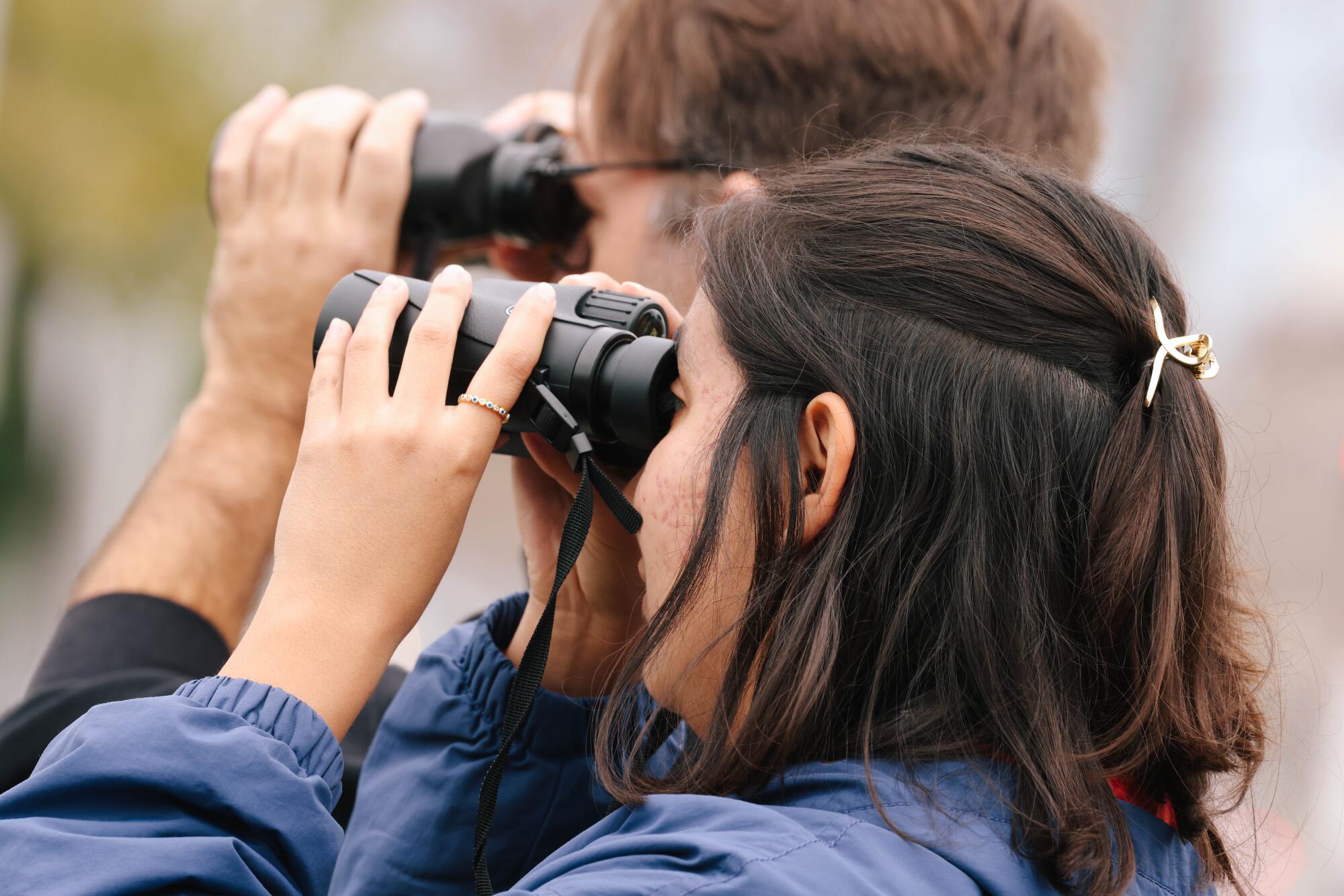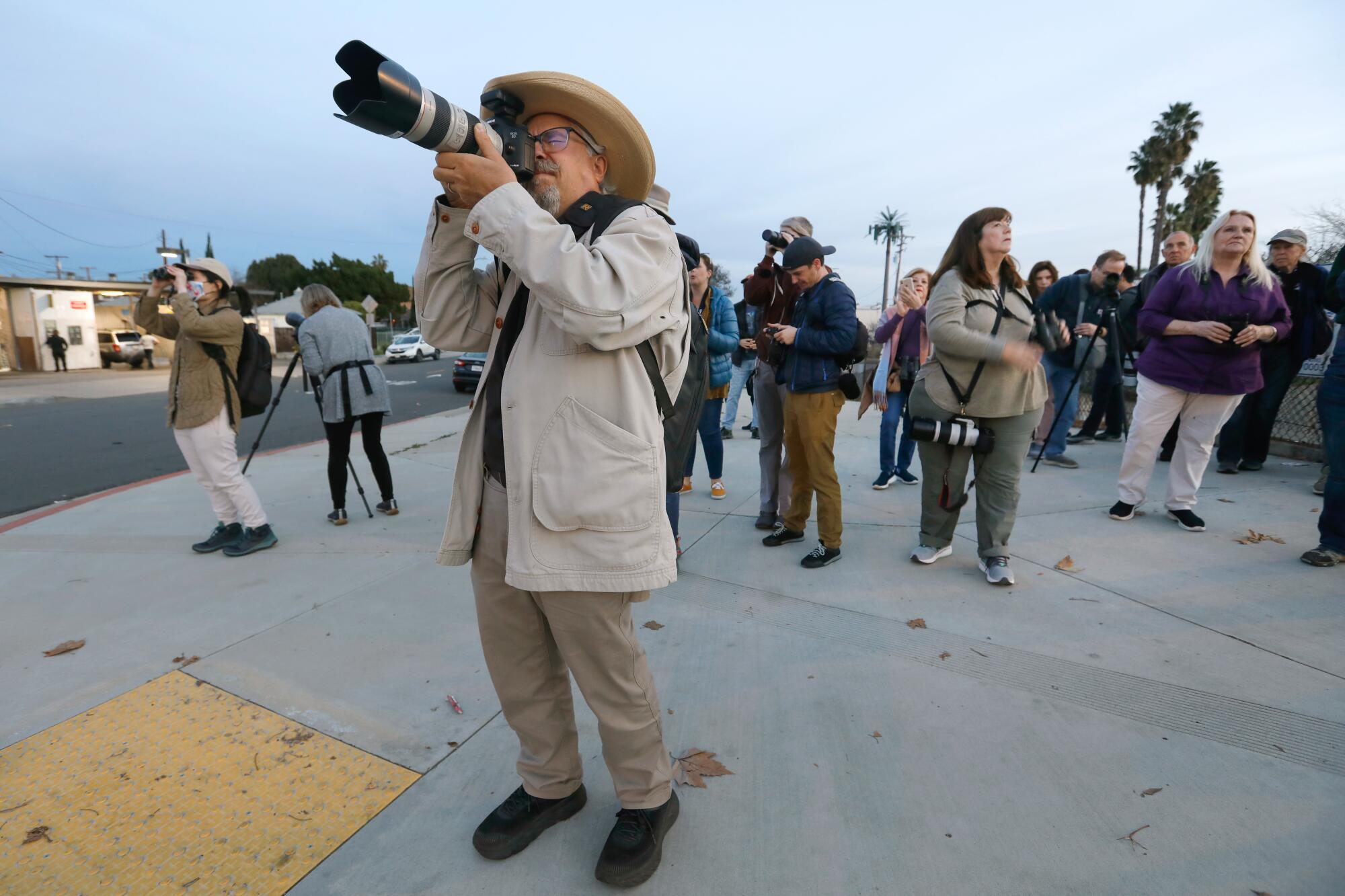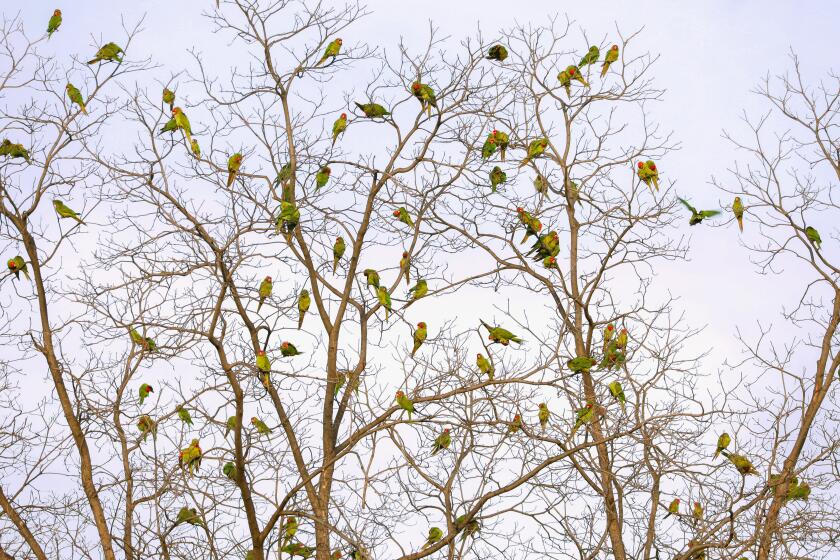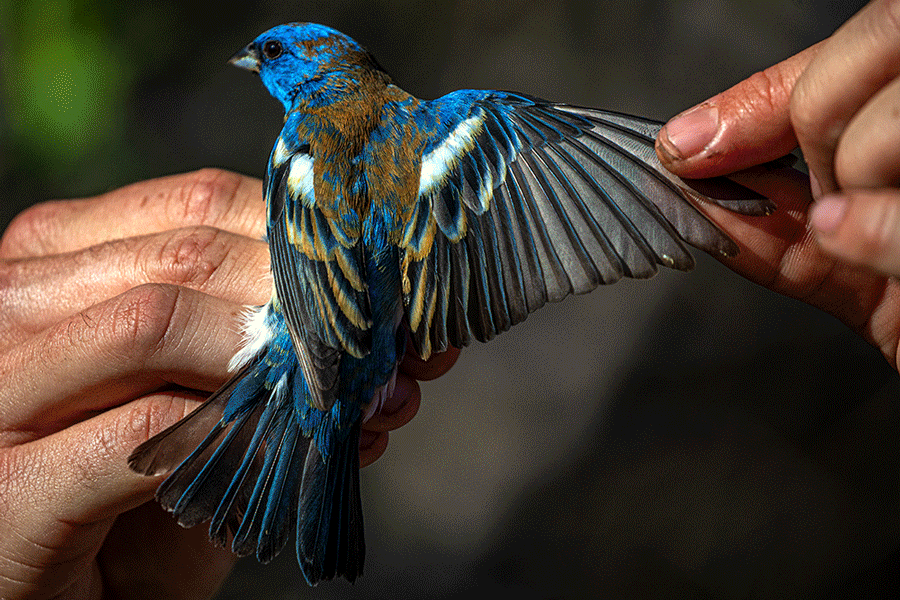
- Share via
During a walk through the Huntington Botanical Gardens with her mother one morning, Brenda Ramirez was alarmed by the sudden squawks, warbles, and screeches of troops of parrots flying overhead at great speed in tight, precise formations.
“I asked my mom what they were,” Ramirez recalled of that day 14 years ago. “She said, ‘Mija, they are just like the parrots from Mexico we’ve seen in zoos, except for one thing: They are free flying and breed in the trees along our city streets.”
Aggressive and impactful reporting on climate change, the environment, health and science.
Ramirez was entranced by this fleeting glimpse of adaptation by tropical species in one of the world’s greatest asphalt jungles.
Now, at 27, she leads a team of investigators at the Free Flying Los Angeles Parrot Project based in Occidental College’s Moore Laboratory of Zoology, which aims to resolve a biological puzzle: How did red-crowned and lilac-crowned parrots establish local urban breeding populations via the pet trade from Mexico, where both species are on the brink of extinction?

A potential answer is that Southern California cities have only in the last 100 years provided these sister species with a resource untapped by native birds: the fruits and flowers of exotic trees used for landscaping, according to the team’s new report in the journal Diversity and Distributions.
Their findings add to a growing body of evidence that some introduced species including these feral parrots can experience rapid niche shifts beyond what appears to be possible in the forested regions of northern Mexico they evolved in.
For example, the driest month in Southern California is significantly drier than any portion of their native habitats in the western and eastern coastal regions of Mexico, the study says. The timing of the precipitation here is also different, with a winter rainfall regime rather than summer rains.
There are a couple of reasons you might be finding it harder than ever to tune out the squawks, whistles and trills of Los Angeles’ wild parrots.
“Artificial irrigation may close the gap between native and introduced climates,” the study suggests, “allowing more year-round vegetation in Southern California cities than expected given its natural precipitation levels.”
That “urban oasis effect” created by sprinkler watering systems “could partly explain why introduced parrots do not seem to be spreading beyond urban centers,” it says. “Their intelligence and behavioral plasticity might further allow them to adapt to urban life.”

The look of Southern California’s green canopies has changed significantly since the 1950s and ’60s, when developers turned up their noses at native oaks and sycamores. They chose instead to landscape their subdivisions, apartment complexes, business parks, shopping centers and roadways with nonnative trees, including sweet gums, camphor, carrotwood, fig, and ficus trees — all favored by parrots.
For reasons that are not fully understood, several hundred parrots seek evening accommodations each night in the limbs of fig and London plane trees lining a bustling stretch of Rosemead Boulevard in Temple City. The odd locale is believed to be one of the most populous roosting sites for parrots in the Los Angeles area.
Chan Quach flies his macaws in L.A. parks, rides his bike with them and takes them out to eat. It’s all part of his mission to make L.A. love birds.
“It’s just cultural memory: They spend all day feeding on the seeds, berries, and flowers of the surrounding tropical treescape,” said John McCormack, director and curator of the Moore Lab of Zoology, during a recent visit to the boulevard. “At sundown, they come together here to rest and sleep.”
The parrots are beloved overnighters here, and residents are on constant alert for poachers. A video of nets in the trees and an unidentified man slamming captured parrots against a concrete wall between Rosemead Boulevard and East Las Tunas Drive on Oct. 26 fueled angry calls and letters to the local Los Angeles County sheriff’s station, City Hall and other government agencies.

It remains unclear whether the man shown in the video was killing some of the parrots he trapped and taking others with him to sell on the illegal wildlife market.
Those birds and other introduced species of parrots and parakeets that have found niches in the clatter and commotion of Southern California city life are believed to be descendants of released pets, especially during the 1970s and ’80s, when the illegal importation of such wild birds reached its peak, according to the study.
How did a dirt parking lot in the San Gabriel Mountains become a major flyway for migrating birds? Scientists can only guess.
Red-crowned parrots, whose home range is restricted to the lowlands of northeast Mexico, were first recorded in the Los Angeles area in 1963. Since then, the population has swelled to more than 3,000 birds, the study says.
The number of lilac-crowned parrots, which are endemic to tropical lowlands in west Mexico and became established locally in the 1980s, is about 800 birds.
Given that both species are considered endangered in their home ranges in Mexico due to habitat loss and trapping for the pet trade, local established flocks have become prized for their conservation potential.

The two species are so similar in size and color that even experts have a tough time telling them apart. Both are crow-sized, chunky birds that establish lifelong pair bonds that usually produce one brood per breeding season.
However, both species have been seen together in the same flocks, underlining the importance of monitoring the birds for signs of hybridization that could undermine proposals to reintroduce urban parrots from Southern California to their native habitats in Mexico.
In the meantime, the Moore Lab Project aspires to become a hub for urban parrot ecology.
For her mother’s birthday on Nov. 12, Ramirez took her to Rosemead Boulevard to witness the unusual sundown spectacle of squawking parrots plunging into the trees.
“As the sun was setting, we could hear them flying in from all directions,” she recalled. “I turned to my mother and said, ‘This is as good as it gets.’”













